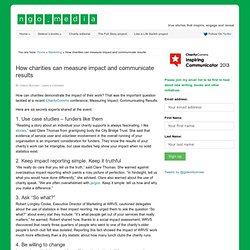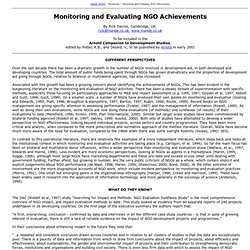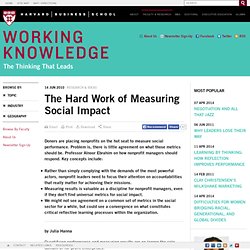

Reflections on Theories of Change in International Development. Danielle Stein and Craig Valters have recently published Theories in Practice papers on Community Mediation and Social Harmony in Nepal and Sri Lanka .

Here they raise some ongoing questions facing those engaging with Theories of Change. Increasingly, international development NGOs are creating ‘Theories of Change’ to explain how and why their interventions work. Theories of Change commonly take the form of a written document, although the concept can also be part of a reflective approach to development thinking (discussed in our paper here , and in various other places such as here ).
It has become common for donors to require written Theories of Change as part of monitoring and evaluation, although some organisations use the concept voluntarily. However it is used, Theory of Change is commonly understood as a way to draw out implicit and explicit ‘assumptions’ about change processes. What’s the impact of one pink dress? Impact investment is the latest buzz term in development funding circles.

It refers to investments made with the goal of generating quantifiable social, environmental and financial returns. I run a development organization, Ubuntu Education Fund, and I believe that our model is an example of an excellent impact investment. I see the value of impact investments, but I’m appalled at some of the misguided language currently in use, particularly the language of “cost-effectiveness.”
Google “impact investment” and you’ll find all sorts of metrics defining cost-effectiveness and solicitations that ask you to donate your money to people who give you the most bang for your buck. When I’m raising money in New York or London, people often ask, “How many kids can I get for ten thousand dollars?” Currently, there’s a boom in rating agencies that focus on nonprofits. GiveWell’s favorite charity is the Against Malaria Foundation. By GiveWell standards, Ubuntu is way off the charts. Measuring Your Nonprofit's Results - Tips for Measuring a Nonprofit's Results.
Monitoring & Evaluation. How charities can measure impact and communicate results. How can charities demonstrate the impact of their work?

That was the important question tackled at a recent CharityComms conference, Measuring Impact, Communicating Results. Here are six secrets experts shared at the event: 1. Use case studies – funders like them “Reading a story about an individual your charity supports is always fascinating. 2. “We really do care that you tell us the truth,” said Clare Thomas. 3. Robert Longley Cooke, Executive Director of Marketing at WRVS, cautioned delegates about the use of statistics in their impact reorting. 4.
In a session entitled “How was it for you?” 5. Brian Lamb, former Executive Director of Advocacy and Policy at RNID, had some great advice for delegates from smaller charities, who might struggle to come up with the facts needed to report impacts. 6. Jeremy Nicholls, Chief Executive of the Social Return on Investment (SROI) Network, offered delegates the basics in measuring impact using the SROI model. Monitoring and Evaluating NGO Achievements. Monitoring and Evaluating NGO Achievements By Rick Davies, Cambridge, UK.rick@mande.co.uk, www.mande.co.uk To be included in theArnold Companion to Development Studies, edited by Potter, R.B., and Desaid, V., to be published by Arnold in early 2001 Over the last decade there has been a dramatic growth in the number of NGOs involved in development aid, in both developed and developing countries.

The total amount of public funds being spent through NGOs has grown dramatically and the proportion of development aid going through NGOs, relative to bilateral or multilateral agencies, has also increased. Associated with this growth has been a growing concern about identifying the achievements of NGOs. In contrast to this operational literature, there are relatively few examples of a more independent literature, which steps back and looks at the institutional context in which monitoring and evaluation activities are taking place (e.g. Ambitious expectations Complexity caused by scale Riddell, R.
Measuring Social Impact. Quantifying performance and measuring results are no longer the sole domain of for-profit enterprises.

Today, many nonprofit organizations also find themselves on the hot seat—not with stockholders but with donors who expect similar levels of accountability to show how their money was spent and what that spending achieved. Yet there has been little agreement on a set of hard-and-fast metrics to measure social performance.
How should a nonprofit manager respond when a significant donor asks for proof of his or her contribution's impact on a particular social issue? “The basic idea is that not everyone needs to measure impact.” "There are two big conversations among nonprofit leaders," says HBS associate professor Alnoor Ebrahim. In two working papers that break down what makes social impact easier or more difficult to measure (one coauthored with HBS professor V. Effectiveness · Sector · Bond. The central questions of effectiveness are simple: Do we achieve the changes in the lives of those we aim to support that we claim?

Can we show that credibly? How can we continually learn and do better? These claims we make are not small: reduced poverty, protection of rights, saving lives and much more. Our effectiveness programme aims to strengthen NGOs' ability to manage, evaluate and be accountable for their work. NGO Assessment Tool. NGO Accountability.